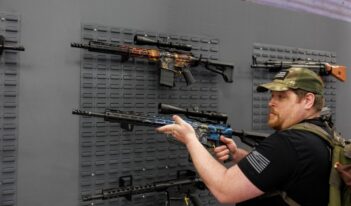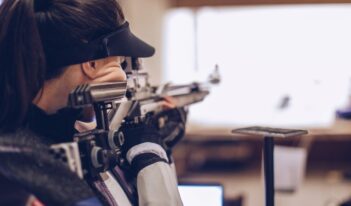
Scholar argues that guns should be regulated as consumer products.
What if the United States regulated real firearms as stringently as they regulated toy guns for children?
In a forthcoming article, Benjamin Cavataro, a professor at the Villanova University Charles Widger School of Law, proposes that Congress empower the Consumer Product Safety Commission (CPSC) to regulate guns in the same way that it regulates other consumer products, such as toys.
Cavataro argues that empowering the CPSC to regulate guns would increase their safety without encroaching on politically charged issues such as gun access and prevalence.
Cavataro explains that, under existing law, if a toy rifle malfunctions and endangers consumers, the manufacturer is required to notify the CPSC, recall the product, and provide a refund or replacement to the toy rifle’s owner. But firearms manufacturers have no similar obligations if one of their weapons malfunctions. He traces this discrepancy back to the 1970s, when Congress, in an effort led by allies of the National Rifle Association, withheld from the CPSC the authority to regulate firearms and ammunition.
As a result, not only is gun product safety not overseen by the CPSC, but Congress also placed gun product safety out of the reach of any other federal regulatory body. The legal remedies for someone injured by defects in guns are available only through civil lawsuits.
Cavataro notes that subsequent efforts to introduce product safety regulations have fallen short because product safety measures for firearms are often seen as “gun control.” Cavataro contends that this characterization is misleading. Instead, he distinguishes between product safety measures, which seek to protect firearm users from dangerous mishaps, and gun control efforts, which seek to regulate the possession and use of guns.
Although firearm manufacturers and industry supporters often contend that accidental gun discharges are the fault of the user and not a product defect, Cavataro argues that this is not the case.
The Remington 700 rifle, for example, occasionally fired without any person pulling the gun’s trigger, according to Cavataro. And even though Remington was aware of the problem as early as 1979, it did not issue a recall until 2014, after several tragic high-profile incidents occurred.
Cavataro also recounts stories of pistols that fired when dropped on the ground. He refers to another handgun model used by the New Jersey State Police that would not fire even when the trigger was pulled.
Cavataro acknowledges that a firearm industry group devises some product safety standards, but he contends that those standards are both too minimal and only apply on a voluntary basis.
In addition, he asserts that gun companies themselves engage in little self-regulation. Although gun companies do occasionally conduct recalls of unsafe firearms, these recalls are often too vague and underpublicized to be effective, argues Cavataro.
Furthermore, he argues that private lawsuits against firearm companies by injured individuals are not enough to ensure guns are manufactured without defects. Cavataro explains that lawsuits are often brought only by gun owners who have been seriously injured, not those who own a defective gun but have avoided injury.
In addition, Cavataro suggests that product liability lawsuits are flawed as a regulatory device because they are backwards-looking. These lawsuits provide financial compensation to injured individuals but require little corrective action from gun companies going forward.
Cavataro notes that a few states have achieved promising results after regulating firearms under state product safety statutes. He argues that Congress must follow suit and grant the CSPC the authority to regulate the safety of firearms as any other consumer product—without giving it power to take other gun control measures. Under this approach, gun manufacturers would be required to report defects to the CSPC, and the Commission would have the power to oversee recalls and enact mandatory safety standards across the industry.
Cavataro acknowledges that his proposal is not likely to receive widespread legislative support in a politically polarized Congress. He concludes, however, that his proposal should not be seen as a measure designed to limit or expand gun access, but instead as a step forward to protect consumers from the real risks associated with gun defects.



